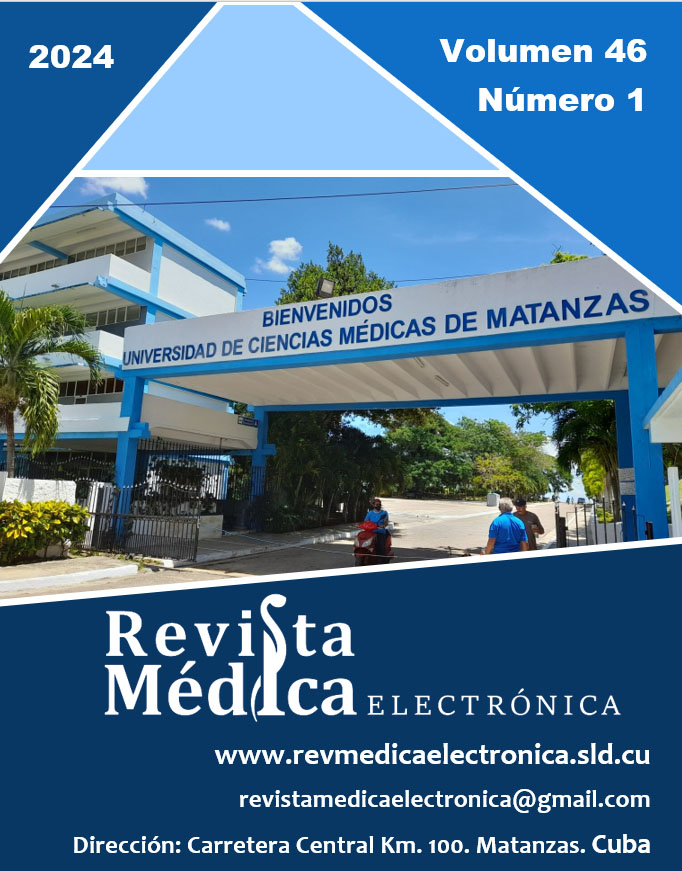Incidence of technostress as a psychosocial risk in teachers of a Faculty of Industrial Engineering
Keywords:
psychosocial risks, technostress, university teachersAbstract
Introduction: The prevention of psychosocial risks contributes to increasing the efficiency of workers. Techno-stress stands out as an emerging psychosocial risk worldwide. Teleworking and the continuous use of the information and communication technologies are the main generators of techno-stress today. Higher education teachers are a vulnerable population given their high work content, which involves the use of information and communication technologies, part of which they take home.
Objective: To assess the incidence of technostress in teachers of the Faculty of Industrial Engineering fof the University of Matanzas.
Methods: The study presented is explanatory, descriptive and quantitative, and aims. It aims to specify the characteristics of the process and to process the collected data. It has as a sample 38 teachers to whom the Technostress survey and the RED-TIC questionnaire were applied as tools, using Statistical Package for the Social Sciences software for validation.
Results: Medium-high results were obtained in the affective and cognitive dimensions of technostress, and a prevention plan was developed to mitigate the risk.
Conclusions: The Technostress survey and the RED-TIC questionnaire are very useful tools to identify the behavior and demands of the population under study, and to evaluate the incidence of technostress in any of its dimensions, respectively. Based on the analysis of their results, they allow to develop a prevention plan with the aim of reducing the present or future effects of technostress as a psychosocial risk.
Downloads
References
2. Acosta Prieto JL, Cordoví Santana LA, Pérez Botino LM. Identificación de los factores de riesgos psicosociales presentes en los trabajadores docentes del departamento industrial de la Universidad de Matanzas [Internet]. Matanzas: Universidad de Matanzas; 2018 [citado 04/01/2024]. Disponible en: https://www.researchgate.net/publication/378486943_IDENTIFICACION_DE_LOS_FACTORES_DE_RIESGOS_PSICOSOCIALES_PRESENTES_EN_LOS_TRABAJADORES_DOCENTES_DEL_DEPARTAMENTO_INDUSTRIAL_DE_LA_UNIVERSIDAD_DE_MATANZAS
3. Rodríguez Vásquez DJ, Totolhua Reyes BA, Domínguez Torres L, et al. Tecnoestrés. Enseñanza e Investigación en Psicología [Internet]. 2021 [citado 04/01/2024];3(2):214. Disponible en: https://revistacneipne.org/index.php/cneip/article/view/122
4. Villavicencio Ayub E, Ibarra Aguilar DG, Calleja N. Tecnoestrés en población mexicana y su relación con variables sociodemográficas y laborales. Psicogente [Internet]. 2020 [citado 04/01/2024];23(44):27-53. Disponible en: http://www.scielo.org.co/scielo.php?pid=S0124-01372020000200027&script=sci_arttext
5. Suria R. Utilización de las tecnologías, tecnoestrés, y su influencia en el rendimiento académico en estudiantes universitarios. The UB Journal of Psychology [Internet]. 2023 [citado 04/01/2024];53(2). Disponible en: https://raco.cat/index.php/AnuarioPsicologia/article/view/4
6. Peralta Beltrán AR, Bilous A, Flores Ramos CR, et al. El impacto del teletrabajo y la administración de empresas. RECIMUNDO [Internet]. 2020 [citado 04/01/2024];4(1):326-35. Disponible en: https://dialnet.unirioja.es/servlet/articulo?codigo=7402204
7. Tomasina F, Pisani A. Pros y contras del teletrabajo en la salud física y mental de la población general trabajadora: una revisión narrativa exploratoria. Archivos de prevención de riesgos laborales. 2022;25(2):147-61. DOI: 10.12961/aprl.2022.25.02.07.
8. Díaz Vera JP, Ruiz Ramírez AK, Egüez Cevallos C. Impacto de las TIC: desafíos y oportunidades de la Educación Superior frente al COVID-19. Revista Científica UISRAEL. 2021;8(2):113-34. DOI: 10.35290/rcui.v8n2.2021.448.
9. Cardenas Velasquez AJ, Bracho Paz DC. El Tecnoestrés: Una consecuencia de la inclusión de las TIC en el trabajo. Cienciamatria [Internet]. 2020 [citado 04/01/2024];6(1):295-314. Disponible en: https://dialnet.unirioja.es/servlet/articulo?codigo=7390786
10. García Dihigo J, Cisnero Gutiérrez Y. Metodología de la investigación para las Ciencias Administrativas. 2ª ed. Matanzas: Universidad de Matanzas; 2005.
11. Moscoso Mena VA, Pineda Bustos LS, Jerez Jaimes AM, et al. Estrategias de prevención del tecnoestrés para trabajadores del Liceo Luther King, ubicado en Bogotá [tesis en Internet]. Bogotá: Corporación Universitaria Minuto de Dios; 2019 [citado 04/01/2024]. Disponible en: https://repository.uniminuto.edu/items/3b9ece9e-fe7f-4e8e-9e73-2df467735e78
12. Eidman L, Basualdo Felleau SE. Adaptación y validación de la escala RED-tecnoestrés en población de estudiantes universitarios argentinos. ACADEMO. 2021;8(2):178-88. DOI: 10.30545/academo.2021.jul-dic.7.
13. Domínguez Torres L, Rodríguez Vásquez DJ, Totolhua Reyes BA, et al. Tecnoestrés en docentes de educación media superior en el contexto de confinamiento por COVID-19: Un estudio exploratorio. Dilemas contemporáneos. 2021;Esp(4). DOI: 10.46377/dilemas.v9i.2950.
14. Castellanos Alvarenga LM, Miranda Rosas LF, Quiroz Moya MS, et al. Regulación emocional y tecnoestrés en docentes de educación superior. Una revisión sistemática. Rev Logos Cienc Tecnol [Internet]. 2024 [citado 15/03/2024];16(1):193-212. Disponible en: http://www.scielo.org.co/scielo.php?script=sci_arttext&pid=S2422-42002024000100193
15. Garcia Ramos MA, Solis Ojeda LV, Unda Rojas S. Tecnoestrés en docentes universitarios en el marco de la pandemia COVID-19. Rev int educ [Internet]. 2022 [citado 04/01/2024];10(1):1-14. Disponible en: https://dialnet.unirioja.es/servlet/articulo?codigo=8442089
16. Gañán Moreno A, Correa Pérez JJ, Ochoa Duque SA, et al. Tecnoestrés laboral derivado de la virtualidad obligatoria por prevención del covid-19 en docentes universitarios de Medellín (COLOMBIA). Trabalho (En) Cena [Internet]. 2021 [citado 04/01/2024];6(1):23. Disponible en: https://www.academia.edu/download/65848648/9673_Texto_do_artigo_51749_1_10_20201222_1_.pdf
Downloads
Published
How to Cite
Issue
Section
License
All content published in this journal is Open Access, distributed under the terms of the CC BY-NC 4.0 License.
It allows:
- Copy and redistribute published material in any medium or format.
- Adapt the content.
This will be done under the following terms:
- Attribute the authors' credits and indicate whether changes were made, in which case it must be in a reasonable way.
- Non-commercial use.
- Recognize the journal where it is published.
The copyrights of each article are maintained, without restrictions.






